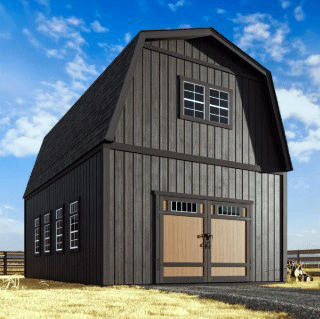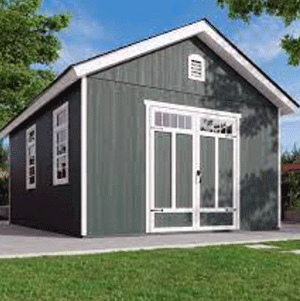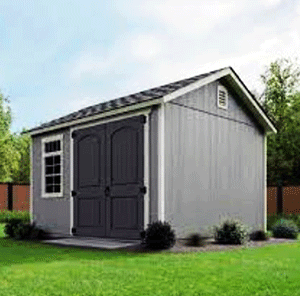Listen up, folks—Costco’s Gorilla Shed is a backyard beast you need in your life. I was skeptical at first, but after setting up my own, I’m sold. It’s sturdy, versatile, and turns your outdoor space into a storage or workspace dream. In this review, I’m diving deep into my experience with the Gorilla Shed, sharing the highs, lows, and tips to make it shine. From comparisons to maintenance hacks, I’ve got you covered. Trust me, this shed’s worth every penny, and your backyard’s begging for one.
My Gorilla Shed Journey: From Chaos To Organized Bliss

My backyard used to be a disaster zone—tools scattered, bikes rusting, and random junk piling up like a bad reality show. I needed a fix, and fast. Enter Costco’s Gorilla Shed, specifically the Elite model in a 12×10 size. I snagged it during a roadshow event, and let me tell you, it’s been a game-changer. But it wasn’t all smooth sailing—there were hiccups, triumphs, and a whole lot of learning. Here’s how it went down.
The buying process was a breeze. I caught the Gorilla Shed display at my local Costco, where a rep walked me through sizes and features. I opted for professional installation (included in the price, score!), since I’m no Bob the Builder. Delivery took about three weeks, and the crew showed up ready to roll. They leveled the ground, laid a gravel base, and had the shed up in a day. The thing looked like a mini fortress—fiberglass doors, beefy wood frame, and a roof that screamed “bring it on, rain.”
Inside, I was stoked to find a loft, shelf, and pegboard ready for action. I turned it into a workshop/storage hybrid, with room for my tools, lawnmower, and even a little workbench for tinkering. But there were quirks—like figuring out the base prep and dealing with a finicky lock. Eight months in, it’s still my backyard MVP, though I’ve learned a thing or two about keeping it tip-top. Let’s break it down.
Pros Of The Costco Gorilla Shed: Why I’m A Fanboy
This shed’s got me grinning for these reasons:
Also Read: My Thought on Osborne Homes
- Rock-solid build: North American wood and fiberglass doors make it feel like a tank. No warping or wobbling here.
- Pro installation included: The crew handled everything—delivery, assembly, caulking. I just sipped coffee and watched.
- Spacious interior: My 12×10 fits a mower, bikes, and a workbench with room to spare. No claustrophobia here.
- Weatherproof champ: Rain, wind, sun—it shrugs it all off. My stuff stays dry as a bone.
- Extra features: Loft, shelf, pegboard—it’s like the shed knew I needed organization before I did.
- Flexible door placement: Choose eave or gable side for doors. I picked eave to fit my yard’s layout.
- High sidewalls: At 6’4”, I can stand tall without smacking my head. No crouching required.
- Secure locking: Heavy-duty locks keep my tools safe. No worries about break-ins so far.
- Customizable sizes: From 10×8 to 16×10, there’s a fit for any yard. I went mid-range and love it.
- Costco’s guarantee: Their return policy and support give me peace of mind. No buyer’s remorse.
The build quality blows me away—my shed’s taken a beating from storms and still looks brand-new. Installation was a dream; I didn’t lift a finger, and the crew was pro-level. The space inside feels like a TARDIS—way bigger than it looks. And those extras? The loft’s perfect for seasonal gear, and the pegboard keeps my tools in check. It’s not just a shed; it’s my backyard command center.
Cons Of The Costco Gorilla Shed: The Not-So-Fun Stuff
No shed’s perfect, and the Gorilla has its quirks. Here’s what got under my skin:

- Pricey upfront: Starting at $4,500, it’s a wallet punch. Cheaper sheds exist if you’re on a tight budget.
- Base prep hassle: You need a level foundation—gravel or concrete. I paid extra for gravel since my yard was a mess.
- Limited online availability: You often need a Costco roadshow to buy. No impulse purchases here.
- Lock issues: My door lock was sticky at first. A little WD-40 helped, but it shouldn’t ship like that.
- Long delivery wait: Three weeks felt like forever. Patience isn’t my strong suit.
- No insulation: It’s bare-bones, so winter gets chilly inside. I added foam boards, but that’s extra work.
- Hinge concerns: Some users online griped about weak hinges. Mine are fine, but I’m watching them.
- Permit costs: Florida folks need a permit, which adds to the bill. Check your local rules first.
- Assembly errors: My crew misaligned a shelf slightly. Fixed it myself, but it was annoying.
- No windows standard: You’ll pay extra for windows if you want light. I skipped them to save cash.
The price stung—I could’ve bought a used car for that! Base prep was a headache; my sloped yard needed pro leveling. Waiting for delivery tested my sanity, and that sticky lock had me cursing. Insulation’s a must if you’re in a cold zone, and I’m still paranoid about those hinges after reading reviews. It’s a solid shed, but you’ll jump through some hoops.
Gorilla Shed Vs. Other Brands: The Backyard Showdown
I shopped around before committing, so here’s how the Gorilla Shed stacks up against Tuff Shed, Lifetime, and Suncast.
- Gorilla Shed vs. Tuff Shed:
- Price: Gorilla starts at $4,500; Tuff Shed’s similar but can hit $6,000 with add-ons.
- Installation: Gorilla’s included; Tuff Shed charges extra unless you DIY.
- Build: Both use wood, but Gorilla’s fiberglass doors feel tougher than Tuff’s metal.
- Features: Gorilla’s loft and pegboard win; Tuff Shed’s bare unless you upgrade.
- Durability: Gorilla’s held up great; Tuff Shed’s known for rot if not maintained.
- Sizes: Both offer variety, but Gorilla’s 16×10 maxes out bigger.
- Warranty: Gorilla’s material warranty shines; Tuff’s shorter unless you pay up.
- Looks: Gorilla’s sleeker; Tuff Shed’s boxy unless you customize.
- Delivery: Gorilla’s 3-6 weeks; Tuff Shed can be faster locally.
- Value: Gorilla’s extras make it feel premium for the price.
- Gorilla Shed vs. Lifetime:
- Material: Gorilla’s wood vs. Lifetime’s resin. Wood looks classier; resin’s low-maintenance.
- Cost: Lifetime’s $1,000-$2,000 vs. Gorilla’s $4,500+. Big gap for budget shoppers.
- Assembly: Gorilla’s pro-installed; Lifetime’s DIY (and a pain, per reviews).
- Durability: Gorilla weathers storms; Lifetime resists rust but dents easier.
- Space: Gorilla’s roomier; Lifetime’s 8×12 felt cramped in demos.
- Features: Gorilla’s loft and shelf vs. Lifetime’s basic interior.
- Security: Gorilla’s locks are beefier; Lifetime’s latches feel flimsy.
- Aesthetics: Gorilla’s like a mini cabin; Lifetime’s plastic-y vibe.
- Warranty: Gorilla’s longer; Lifetime’s solid but shorter.
- Setup: Gorilla’s crew vs. Lifetime’s 7-hour slog I read about.
- Gorilla Shed vs. Suncast:
- Build: Gorilla’s wood vs. Suncast’s resin. Wood’s sturdy; resin’s lighter.
- Price: Suncast’s $500-$1,500 vs. Gorilla’s $4,500. Suncast wins for cheap.
- Installation: Gorilla’s included; Suncast’s DIY with snap-together parts.
- Size: Gorilla’s bigger options; Suncast maxes at 8×10.
- Weather: Gorilla’s storm-proof; Suncast fades in sun, per reviews.
- Features: Gorilla’s pegboard and loft vs. Suncast’s empty shell.
- Security: Gorilla’s locks vs. Suncast’s basic latches.
- Looks: Gorilla’s premium; Suncast’s utilitarian.
- Durability: Gorilla’s built for decades; Suncast’s 5-7 years max.
- Value: Gorilla’s investment; Suncast’s quick fix.
Gorilla Shed’s a heavyweight. Tuff Shed’s close but pricier with fewer perks. Lifetime and Suncast are budget-friendly, but you get plastic vibes and less space. For a long-term, pro-grade shed, Gorilla’s my pick—it’s like the Cadillac of backyard storage.
Maintenance And Tips: Keeping Your Gorilla Shed Like New
Your shed’s up—now keep it awesome. Here’s how to make it last:

- Seal the wood: Apply a weatherproof sealant yearly. I use Thompson’s WaterSeal to fend off rot.
- Check hinges: Inspect every six months for loose screws. Tighten or replace to avoid sagging.
- Clean the roof: Clear leaves and debris monthly. A clogged roof invites water damage.
- Lube the lock: WD-40 every few months keeps it smooth. My sticky lock’s history now.
- Ventilate inside: Crack a window (if you added one) to prevent mold. I use a small fan in humid months.
- Organize smart: Use the loft for light stuff, pegboard for tools. Keeps the floor clear for big gear.
- Inspect caulking: Reapply silicone caulk around seams if cracks appear. Mine needed a touch-up at six months.
- Avoid heavy loads: Don’t overload the loft—it’s for boxes, not anvils. Learned that the hard way.
- Winter prep: Clear snow off the roof ASAP. Heavy snow can stress the frame.
- Paint if you want: A fresh coat every few years boosts looks and protection. I went with gray for style.
Also Read: My Thought on Osborne Homes
I seal my shed every fall—it’s a quick job that saves headaches. Checking hinges is a 10-minute chore that keeps doors tight. Clearing the roof’s a pain, but it beats leaks. Lubing the lock’s a lifesaver, and my fan trick keeps it fresh inside. Organizing with the pegboard makes me feel like a pro, and caulking touch-ups are no biggie. These steps keep my shed looking and working like day one.
Frequently Asked Questions (Faq)
With proper care, I’d say 15-20 years. Mine’s eight months old and pristine with yearly sealing. Wood sheds rot without maintenance, but Gorilla’s build feels built to last.
You don’t set it up—pros do it for you. I watched the crew nail it in a day. Just prep a level base, and you’re golden.
Yep, if you’ve got space and street access for delivery. My yard’s sloped, so I needed gravel leveling. Check your HOA or zoning rules first.
The locks are solid—better than most sheds I’ve seen. No issues in eight months, but I added a padlock for extra peace of mind.
Conclusion: Your Backyard Needs A Gorilla Shed
Eight months with my Costco Gorilla Shed, and I’m still obsessed. It’s turned my chaotic yard into a storage and workshop paradise, with pro installation making it stress-free. Sure, it’s not cheap, and base prep’s a chore, but the space, durability, and features are unmatched. If you want a shed that’s tough, roomy, and built to last, grab a Gorilla Shed.
